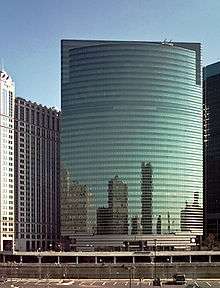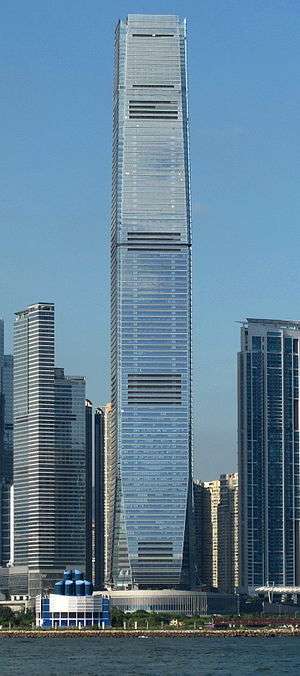Kohn Pedersen Fox
 | |
| Founded | New York City, New York, United States (1976) |
|---|---|
| Founder | A. Eugene Kohn, William Pedersen, Sheldon Fox (dec.) |
| Headquarters |
11 West 42nd Street, New York City, New York, U.S. (Additional offices in London, Shanghai, Hong Kong, Seoul, Abu Dhabi) |
| Services | Architecture, Interior Design, Sustainable Design, Urban Design, Planning |
Number of employees | 550+ |
| Website |
www |
Kohn Pedersen Fox Associates (KPF) is an American architecture firm which provides architecture, interior, programming and master planning services for clients in both the public and private sectors. KPF is one of the largest architecture firms in the world and is currently one of the largest in New York City,[1] where it is located.
Recent work
Today, KPF's projects include civic and cultural spaces, commercial office buildings, transportation facilities, residential and hospitality developments, educational and institutional facilities, and diverse mixed-use commercial developments.[2]
KPF’s projects over the last 10 years include Roppongi Hills in Tokyo (2003), Unilever House in London (2007), the Mandarin Oriental, Las Vegas (2009), the Stephen M. Ross School of Business in Ann Arbor (2009), the RBC Centre in Toronto (2009), the University of Minnesota Science Teaching and Student Services Center (2010), Centra Metropark in Iselin, New Jersey (2011), the Heron Tower in London (2011) and the Buffalo United States Courthouse (2011). Over the past few years, KPF has completed the tallest towers in a number of countries: Lotte World Tower, the tallest in Korea (2015), the International Commerce Centre, the tallest in Hong Kong (2011), Tour First, the tallest building in France (2011).









In New York, KPF is presently designing the Hudson Yards Redevelopment Project, a 26-acre site on Manhattan's West Side that is the largest undeveloped single piece of property on the island.[3] Also in New York, KPF recently completed NYU's new College of Nursing, Dentistry & Bio-Engineering Institute in collaboration with EYP Architects[4] and the 390,000-square-foot CUNY Advanced Science Research Center. KPF recently completed One Jackson Square (2009) and served as Executive Architect for the 10-year phased expansion and renovation of New York's Museum of Modern Art (2005).
Current projects around the world include the Midfield Terminal Complex at the Abu Dhabi International Airport and the 660-meter-tall Ping An Finance Centre in Shenzhen, China.[5]
Approach
KPF's philosophy is firmly rooted in the belief that success is the result of collaboration and dialogue.[6] KPF explains, “A similar sentiment is central to the manner in which we weave our buildings into the environmental fabric." [6] For a firm of its size, KPF takes on an unusually large number of restoration and renovation projects. Examples of this work include The World Bank Headquarters, Unilever House, and The Landmark in Hong Kong. KPF has been recognized for workplace collaboration. KPF’s intranet “Architectural Forum” has been described in Architectural Record as an example of “a resource that contributes to a learning environment through mentoring supporting teams and individuals with new ideas, and sharing best practices”.[7]
Beginnings in the United States (1976–1980s)
Shortly after its founding in 1976, the American Broadcasting Company (ABC) chose KPF to redevelop a former armory building on Manhattan’s West Side to house TV studios and offices. This experience led to 14 more projects for ABC over the next 11 years, as well as commissions from major corporations across the country, including the AT&T and Hercules Incorporated. By the mid-1980s, KPF had nearly 250 architects working on projects in cities throughout the United States. By 1985, even John Burgee (of rival architecture firm John Burgee Architects) called KPF, “The best commercial firm now practicing in the U.S.”[8] KPF's design for 333 Wacker Drive in Chicago (1983), which was awarded the AIA National Honor Award in 1984, made the firm nationally famous. It remains a Chicago landmark, and was voted “Favorite Building” by the readers of the Chicago Tribune in both 1995 and 1997.[9] In 1986, KPF’s Procter & Gamble Headquarters in Cincinnati, which included an open plan interior design by Patricia Conway, was recognized for its innovative design with the AIA National Honor Award. [9] After its success with these projects, KPF was selected to design buildings including the IBM World Headquarters in Armonk, NY (1997), the Chicago Title and Trust Building in Chicago (1992) and the Federal Reserve Bank of Dallas (1993).
In the 1990s, KPF also took on a larger number of government and civic projects, including the Foley Square U.S. Courthouse in New York (1995), the Mark O. Hatfield U.S. Courthouse in Portland, OR (1996), the U.S. Courthouse of Minneapolis (1996), the Buffalo Niagara International Airport (1993) and the multiple award-winning redevelopment of The World Bank Headquarters in Washington, D.C. (1996).
KPF’s winning entry in the international competition for the World Bank Headquarters, which drew 76 entrants from 26 countries, was the only entry that included the retention of existing structures. KPF’s sensitive design solution for the World Bank, its first D.C. project, set the tone for KPF’s future high-profile international work.
Expansion to Europe (1980s–1990s)
In the 1980s and 1990s, KPF transformed from an American firm known for its corporate designs into an international firm with institutional, government, and transportation commissions in addition to corporate work.
KPF completed the design for two blocks of the large-scale Canary Wharf redevelopment (1987) and the Goldman Sachs Headquarters on Fleet Street (1987–1991).[10] KPF has been selected for projects in the Canary Wharf area through the present day, including the Clifford Chance Tower (2002) to the KPMG's European Headquarters (2009). KPF’s subsequent work in the U.K. includes Thames Court in London (1998), the Rothermere American Institute at Oxford University (2001) and the master plan for the London School of Economics (2002). KPF’s design for the award-winning Westendstraße 1 in Frankfurt (1992), an early example of mixed-use design, further increased the firm's international prominence and solidified the firm's reputation as a progressive global practice. KPF was chosen for subsequent projects throughout Europe, including Provinciehuis in The Hague (1998), Danube House in River City, Prague (2003), the expansion and renovation of the World Trade Center in Amsterdam (2004) and the Endesa Headquarters in Madrid (2003).
Work in Asia and internationally (1990s–2009)
KPF's introduction to the Asian market began with the 4,500,000-square-foot (420,000 m2) Japan Railways Central Towers project in Nagoya (1999). Within 10 years, KPF had projects in Japan, Korea, Indonesia, Thailand, Hong Kong, Taiwan and mainland China. Completed KPF projects in Asia include Plaza 66 on Shanghai’s Nanjing Xi Lu (2001), Roppongi Hills in Tokyo (2003), the Rodin Pavilion in Seoul (2003), the Merrill Lynch Japan Head Office in Tokyo (2004) and the Shanghai World Financial Center (2008), which was named the “Best Tall Building Overall” by the Council on Tall Buildings and the Urban Habitat in 2008.[11] KPF worked with renowned structural engineers, Leslie E. Robertson Associates, to maximize the Shanghai tower’s floor plate and material efficiency by perfecting its tapered form.[12] In addition to this work in Asia, KPF has completed projects in: the Middle East, including the Abu Dhabi Investment Authority Headquarters (2007) and the Marina Towers (2008); South America including Ventura Corporate Towers in Rio de Janeiro (2008) and Infinity Tower in São Paulo (2012); Australia, including Chifley Tower in Sydney (1992); and has also worked on several projects in Africa.
Selected projects
- 52-54 Lime Street, London, UK
- 55 Hudson Yards, New York City, USA
- Abu Dhabi Investment Authority Tower, Abu Dhabi, UAE
- Abu Dhabi International Airport Midfield Terminal Concourse, Abu Dhabi, UAE
- Baruch College Newman Vertical Campus, City University of New York, New York City, USA
- Buffalo Niagara International Airport, Buffalo, New York, USA
- Chicago Title and Trust Center, Chicago, Illinois, USA
- Chifley Tower, Sydney, Australia
- CNOOC Building, Beijing, China
- Robert H. Jackson United States Courthouse, Buffalo, New York, USA
- Espirito Santo Plaza, Miami, Florida, USA
- Ernst & Young Tower, Toronto, Ontario, Canada
- Foley Square / Daniel Patrick Moynihan United States Courthouse, New York City, USA
- Heron Tower, London, UK
- Hoftoren, The Hague, Netherlands
- Hysan Place, Hong Kong
- International Commerce Centre, Hong Kong
- Marina Bay Financial Centre, Singapore
- Museum of Modern Art (MoMA) Expansion and Renovation, New York City, USA
- One Vanderbilt, New York City, USA
- RBC Centre, Toronto, Canada
- Ritz-Carlton Toronto, Toronto, Canada
- Mori Tower and Grand Hyatt at Roppongi Hills, Tokyo, Japan
- Rothermere American Institute, University of Oxford, Oxford, UK
- Science Teaching and Student Services Center, University of Minnesota, Minneapolis, Minnesota, USA
- Shanghai World Financial Center, Shanghai, China
- Songdo International Business District, Incheon, Korea
- South Bank Tower, London, UK
- Stephen M. Ross School of Business, University of Michigan-Ann Arbor, Ann Arbor, Michigan, USA
- The Landmark, Hong Kong
- Unilever House, 100 VE, London, UK
- Westendstraße 1, Frankfurt, Germany
- World Bank Headquarters, Washington, D.C, USA
Awards and honors
AIA National Chapter Awards
- AIA National Chapter Architectural Firm Award (1990)
- AIA National Chapter Honor Award for Architecture, Centra at Metropark, Iselin, New Jersey (2013)
- AIA National Chapter Honor Award for Architecture, One Jackson Square, New York City, USA (2011)
- AIA National Chapter Honor Award for Architecture, Unilever House, London, UK (2008)
- AIA National Chapter Honor Award for Architecture, Gannett/USA Today Corporate Headquarters McLean, Virginia, USA (2005)
- AIA National Chapter Honor Award for Architecture, Baruch College Newman Vertical Complex, New York York City, USA (2003)
- AIA National Chapter Honor Award for Architecture, The World Bank Headquarters, Washington, D.C, USA (1998)
- AIA National Chapter Honor Award for Architecture, Westendstraße 1, Frankfurt, Germany (1994)
- AIA National Chapter Honor Award for Architecture, Procter & Gamble Headquarters, Cincinnati, Ohio, USA (1987)
- AIA National Chapter Honor Award for Architecture, 333 Wacker Drive, Chicago, Illinois, USA (1984)
Source:[13]
See also
- Kohn Pedersen Fox buildings
- List of architecture firms
- List of architects
References
- ↑ http://www.crainsnewyork.com/article/20110418/REAL_ESTATE/110419871
- ↑ 'Projects by Type.' Projects. Retrieved 2010-03-03.
- ↑ 'Hudson Yards.' Retrieved 2011-09-07.
- ↑ "NYU Expands Outside Village". Retrieved 2012-05-18.
- ↑ CTBUH Buildings Database Retrieved 2012-05-03
- 1 2 'Overview.' Profile. Retrieved 2010-03-03.
- ↑ Pressman, Andrew. ‘Creating a firm culture that supports innovative design.’ Architectural Record. February 2008. Retrieved 2010-01-08.
- ↑ Giovanni, Joseph. "Kohn Pedersen Fox: Transition and Development, 1986-1992." ed. James Warren. New York: Rizzoli, 1993.
- 1 2 The American Institute of Architects. Architecture Firm Award Recipients. Retrieved 2010-01-08.
- ↑ Kohn Pedersen Fox: Architecture and Urbanism, 1993-2002, eds. Ian Luna and Kenneth Powell. New York: Rizzoli, 2002.
- ↑ Kaplan-Seem, Anya. ‘Shanghai Skyscraper Named ‘Best Tall Building.’ Architectural Record. 24 December 2008. Retrieved 2010-01-08.
- ↑ Kaplan-Seem, Anya. ‘Shanghai Skyscraper Named ‘Best Tall Building.’Architectural Record. 24 December 2008. Retrieved 2010-01-08.
- ↑ http://www.aia.org/practicing/awards/2011/Architecture/index.htm
External links
| Wikimedia Commons has media related to Kohn Pedersen Fox. |